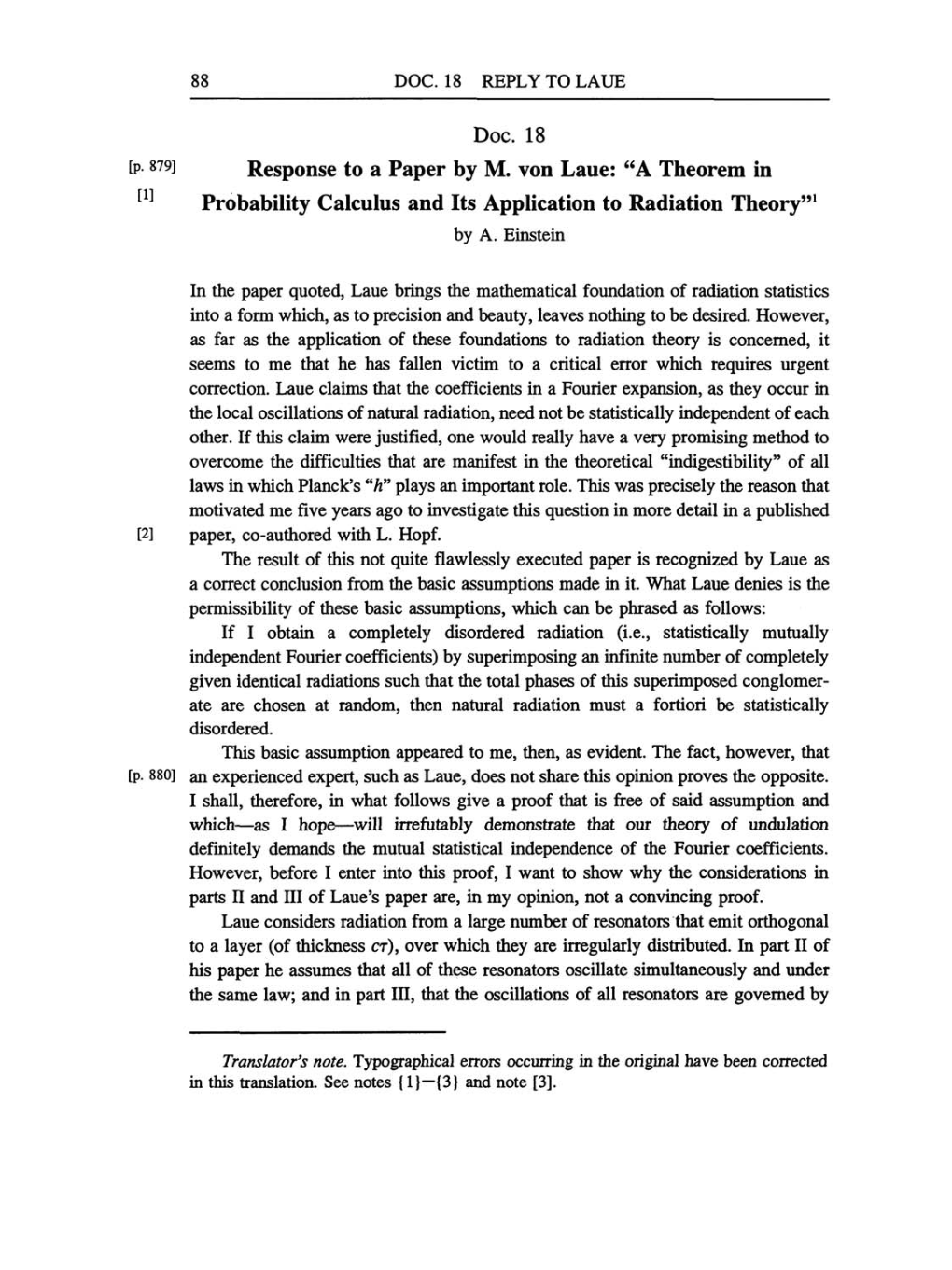88
DOC.
18
REPLY TO LAUE
Doc.
18
Response
to
a
Paper
by
M.
von
Laue: "A Theorem
in
Probability
Calculus and Its
Application
to
Radiation
Theory"1
by
A.
Einstein
[p. 879]
[1]
In the
paper quoted,
Laue
brings
the mathematical foundation
of
radiation statistics
into
a
form
which,
as
to
precision
and
beauty,
leaves
nothing
to be desired.
However,
as
far
as
the
application
of
these
foundations
to
radiation
theory
is
concerned,
it
seems
to
me
that he
has fallen
victim
to
a
critical
error
which
requires urgent
correction. Laue claims that the coefficients in
a
Fourier
expansion,
as
they occur
in
the local oscillations of natural
radiation,
need
not
be
statistically
independent
of
each
other.
If
this claim
were
justified,
one
would
really
have
a
very promising
method
to
overcome
the difficulties
that
are
manifest in the theoretical
"indigestibility"
of all
laws
in which
Planck's "h"
plays an important
role. This
was precisely
the
reason
that
motivated
me
five
years ago
to
investigate
this
question
in
more
detail in
a published
[2] paper,
co-authored with
L.
Hopf.
The result of this
not
quite
flawlessly
executed
paper
is
recognized by
Laue
as
a
correct conclusion from the basic
assumptions
made in
it.
What Laue denies is the
permissibility
of these basic
assumptions,
which
can
be
phrased
as
follows:
If
I
obtain
a
completely
disordered radiation
(i.e.,
statistically mutually
independent
Fourier
coefficients) by
superimposing an
infinite number
of
completely
given
identical radiations such that the total
phases
of this
superimposed conglomer-
ate
are
chosen
at random,
then natural radiation
must
a
fortiori
be
statistically
disordered.
This basic
assumption appeared
to
me, then,
as
evident. The
fact, however,
that
[p.
880] an
experienced expert,
such
as
Laue,
does
not
share this
opinion proves
the
opposite.
I
shall,
therefore,
in what follows
give
a
proof
that is free
of
said
assumption
and
which-as I
hope-will
irrefutably
demonstrate that
our
theory
of undulation
definitely
demands the mutual statistical
independence
of the Fourier coefficients.
However,
before
I enter
into this
proof,
I want
to show
why
the considerations in
parts
II
and III of Laue's
paper
are,
in
my opinion,
not
a convincing proof.
Laue considers radiation
from
a large
number
of resonators that emit
orthogonal
to
a layer
(of
thickness
cr),
over
which
they
are
irregularly
distributed. In
part
II
of
his
paper
he
assumes
that all of these resonators oscillate
simultaneously
and under
the
same law;
and in
part
III,
that the oscillations of all resonators
are governed by
Translator's
note. Typographical
errors
occurring
in the
original
have been corrected
in this
translation.
See
notes {1}-{3}
and note
[3].
